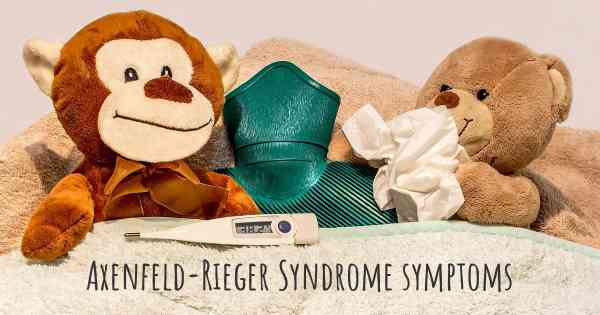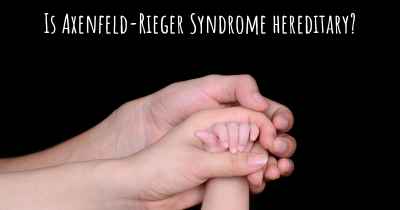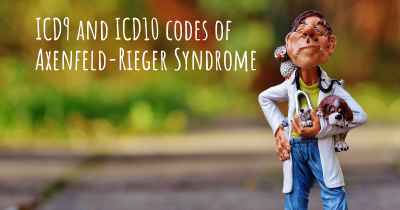Which are the symptoms of Axenfeld-Rieger Syndrome?
See the worst symptoms of affected by Axenfeld-Rieger Syndrome here

Axenfeld-Rieger Syndrome (ARS) is a rare genetic disorder that affects the development of the eye, teeth, and other parts of the body. It is characterized by a wide range of symptoms that can vary in severity from person to person. The syndrome is named after the two ophthalmologists who first described it, Theodor Axenfeld and Hans Rieger.
Ocular Symptoms:
One of the primary features of Axenfeld-Rieger Syndrome is abnormalities in the structure and function of the eyes. These ocular symptoms can include:
- Iris Abnormalities: Individuals with ARS often have iris anomalies, such as a prominent Schwalbe's line (a thickened and anteriorly displaced trabecular meshwork), iris stromal hypoplasia (underdevelopment of the iris), or corectopia (displacement of the pupil).
- Glaucoma: Glaucoma, a condition characterized by increased pressure within the eye, is a common complication of ARS. It can lead to optic nerve damage and vision loss if not properly managed.
- Corneal Abnormalities: Some individuals with ARS may have corneal abnormalities, including thinning or clouding of the cornea.
- Cataracts: Cataracts, a condition characterized by the clouding of the lens of the eye, can occur in individuals with ARS.
- Refractive Errors: Refractive errors, such as nearsightedness (myopia) or farsightedness (hyperopia), are common in individuals with ARS.
Dental and Craniofacial Symptoms:
Axenfeld-Rieger Syndrome can also affect the development of teeth and craniofacial structures. Some of the dental and craniofacial symptoms associated with ARS include:
- Hypodontia: Hypodontia refers to the underdevelopment or absence of teeth. It is a common dental abnormality seen in individuals with ARS.
- Microdontia: Microdontia is a condition characterized by abnormally small teeth. It can also occur in individuals with ARS.
- Malocclusion: Malocclusion, or misalignment of the teeth, is another dental manifestation of ARS.
- Cleft Lip and Palate: In some cases, individuals with ARS may have a cleft lip and/or palate, which are birth defects affecting the upper lip and roof of the mouth.
- Midface Hypoplasia: Midface hypoplasia refers to underdevelopment of the middle region of the face, including the cheekbones and nasal bridge. It can be a characteristic feature of ARS.
Systemic Symptoms:
Axenfeld-Rieger Syndrome is not limited to ocular and dental abnormalities; it can also affect other parts of the body. Some of the systemic symptoms associated with ARS include:
- Cardiac Abnormalities: Certain individuals with ARS may have congenital heart defects, such as atrial septal defects or ventricular septal defects.
- Genitourinary Abnormalities: Some individuals with ARS may have genitourinary abnormalities, including underdeveloped or absent reproductive organs.
- Hearing Loss: Sensorineural hearing loss, which affects the inner ear, can occur in individuals with ARS.
- Developmental Delay: In rare cases, individuals with ARS may experience developmental delays, particularly in speech and motor skills.
- Endocrine Abnormalities: There have been reports of endocrine abnormalities, such as hypothyroidism or growth hormone deficiency, in individuals with ARS.
Genetic Causes:
Axenfeld-Rieger Syndrome is primarily caused by mutations in certain genes that play a role in eye and craniofacial development. The most commonly affected genes are PITX2 and FOXC1, which provide instructions for producing proteins involved in the formation of various tissues during embryonic development. These genetic mutations disrupt the normal development of the eyes, teeth, and other structures, leading to the characteristic symptoms of ARS.
Management and Treatment:
As Axenfeld-Rieger Syndrome is a complex disorder with multiple manifestations, a multidisciplinary approach to management is often necessary. Treatment focuses on addressing the specific symptoms and complications experienced by each individual. Ophthalmologists play a crucial role in monitoring and managing ocular abnormalities, such as glaucoma and cataracts, to preserve vision. Dental interventions, including orthodontic treatment and prosthetic solutions, may be required to address dental abnormalities. Other specialists, such as cardiologists, urologists, and audiologists, may be involved in managing associated systemic issues.
Conclusion:
Axenfeld-Rieger Syndrome is a rare genetic disorder that affects the eyes, teeth, and other parts of the body. The syndrome is characterized by a wide range of symptoms, including ocular abnormalities, dental and craniofacial manifestations, and systemic issues. Early diagnosis and appropriate management are essential to address the specific needs of individuals with ARS and optimize their overall health and quality of life.
Posted Mar 11, 2017 by Missy 1050
Another aspect of ARS that is difficult for me is the genetic dominance of the trait. Although we had been dealing with abdominal, oral/dental and visual symptoms since my birth; I was 26 years old when, during a routine eye exam (-13 diopters corrective lenses) my glaucoma (IOPs mid-50s, visual fields reduced to lower half) was first diagnosed and I was introduced to Riegers. (Axenfeld came later). I was asked if anyone else in my family had glaucoma. No. I was asked if I had children. Yes. It was like being punched in the stomach. My son was three years old at the time, and yes, I passed ARS to him. Forty years later it continues to be a painful burden to bear.
Posted Mar 12, 2017 by Thomas 300
Posted Mar 16, 2017 by Steve 1000








